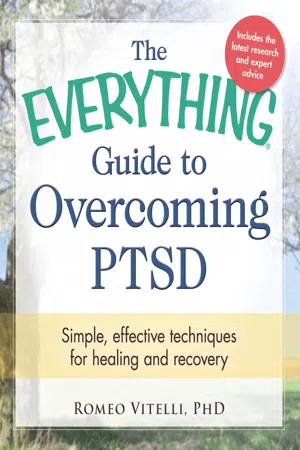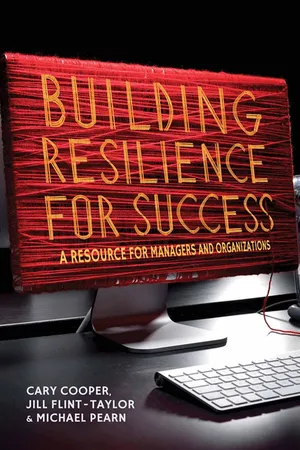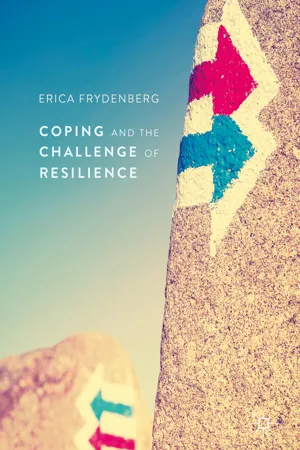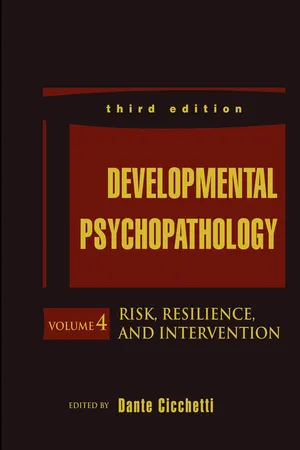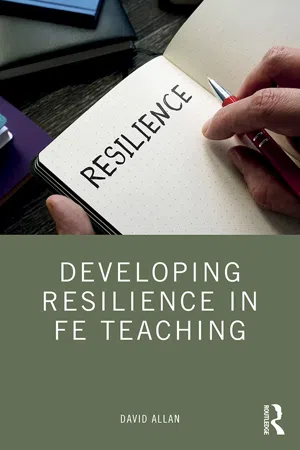Psychology
Resilience
Resilience refers to an individual's ability to adapt and bounce back from adversity, trauma, or stress. It involves the capacity to maintain a sense of well-being and effectively cope with challenges. Resilience is influenced by various factors, including personal traits, social support, and coping strategies, and can be developed and strengthened over time.
Written by Perlego with AI-assistance
Related key terms
Related key terms
1 of 4
Related key terms
1 of 3
11 Key excerpts on "Resilience"
- eBook - ePub
Trauma and Resilience
Your Questions Answered
- Keith A. Young(Author)
- 2021(Publication Date)
- Greenwood(Publisher)
Resilience 21. What is Resilience?Resilience is the durability of our psychological constitution in stressful situations and our ability to adapt to adversity without becoming overwhelmed by it. It’s the protective physiological fortitude that determines how effectively we cope in a moment of crisis and how swiftly we will recover after the crisis has passed. Resilience isn’t one particular asset. It’s a sum total of multiple strengths and attributes that include, among other things, our sense of personal efficacy, the faith we have in ourselves, the degree to which we feel valued and loved by others, our versatility in problem solving, and how effectively we maintain a sense of safety in the world as we understand it. It’s also a measure of wellness and attunement between the mind and the body, including our awareness of somatic distress and how well we’ve learned to tend to it.Resilience is an internal safeguard and our first line of defense against the effects of trauma. It enhances our chances of coming out okay once the danger has passed and we’re on the other side of it. Psychological trauma burdens the mind beyond its threshold to process and metabolize what’s happening. Resilience is what determines how high or low that threshold is set and how much it can be pushed before an overwhelm takes place. It’s a dynamic measure, in that people with high Resilience may become less resilient over time (e.g., from exposure to trauma or compromised wellness), and people with low Resilience can learn skills to raise it. For that reason, you can think of Resilience as both a skill set and the protective bubble that it creates. Resilience gained will speed the process of recovery, and the process of recovery will build Resilience.A high degree of Resilience doesn’t mean that we will never become frazzled or stressed. It doesn’t automatically grant us immunity from becoming traumatized by any particular adverse event. But it does certainly stack the deck in our favor by both mitigating the damage caused and lessening the time it takes to regain our sense of safety. To be resilient doesn’t mean that we become dismissive of horrible things that have happened to us. It isn’t found by closing ourselves off to our emotions or by isolating from connection with others. It’s gained when we’re brave enough to show vulnerability, both to others, when we need to ask for help, and to ourselves, when we’re taking accountability for our choices. Resilience is not false hope. It’s not achieved by staying in unhealthy situations but is what helps us survive and escape them. It’s found in the parts of ourselves that we hold onto for as long as we’re stuck in abusive relationships or traumatic situations and that propel us toward change when it becomes possible. - eBook - ePub
The Everything Guide to Overcoming PTSD
Simple, effective techniques for healing and recovery
- Romeo Vitelli(Author)
- 2014(Publication Date)
- Everything(Publisher)
CHAPTER 16 What Is Resilience?Not every disaster or traumatic event is going to affect people in the same way. Often defined as “the psychological processes that permit individuals to maintain or return to previous levels of well-being and functioning in response to adversity,” psychological Resilience (or simply Resilience, for short) has become a major focus for research into trauma and child development over the past four decades.Research on Resilience
Beginning in the 1970s, research looking at how well children adjusted to growing up in abusive households found that many of these children seemed relatively unharmed by what was happening around them. Though studies showed that as many as 60–70 percent of abused and neglected children developed behavioral and psychiatric problems later in life, a large minority of these children showed remarkable emotional maturity that protected them and allowed for a fairly normal development despite their upbringing. One researcher, Emmy Werner, coined the term “Resilience” to describe what she was finding with these children.Along with at-risk children, researchers have also looked at Resilience in soldiers, people surviving catastrophic life events, physical and sexual abuse, urban poverty, and refugees. Along with reduced risk of PTSD, high Resilience has been linked to lower risk of suicide, reduced risk of substance abuse, depression, and other psychiatric symptoms. Resilient people are also less likely to have health complaints and function better in stressful situations.There can be different ways of measuring Resilience, including whether people cope well with stress, have good outcomes despite being exposed to high levels of stress, recover well from trauma, and are able to learn from their previous traumatic experiences to protect themselves in future. Though Resilience is often linked to cultural differences in survivors, it also appears to involve different types of protective factors that can limit the impact of traumatic events on survivors. These can include: - Peter D. Harms, Pamela L. Perrewé, Chu-Hsiang (Daisy) Chang(Authors)
- 2021(Publication Date)
- Emerald Publishing Limited(Publisher)
As a result, prevailing research now conceptualizes Resilience as a state-like construct which can change in response to stressful events (Bryan et al., 2019 ; Kossek & Perrigino, 2016). From this perspective, we can conceptualize a Resilience process by which individuals successfully use assets and resources to protect themselves against the negative consequences associated with adverse experiences, while promoting the ability to overcome, steer through, and bounce-back from adversity (see Luthar et al., 2000 ; Masten, 2007 ; Richardson, 2002). Waugh and Koster (2015) argue that Resilience is influenced by interpersonal factors (assets) as well as intrapersonal and environmental factors (i.e., resources). These factors can help to progressively develop Resilience over time creating a Resilience capability that allows individual to successfully navigate through a stressful event without suffering long-term adverse effects (Luthar et al., 2000 ; Rutter, 1987). When this occurs individual can be seen to have engaged in successful positive adaptation. The current consensus is that in its simplest form, psychological Resilience occurs when a person can “recover, re-bound, bounce-back, adjust or even thrive” in the face of adversity (Garcia-Dia et al., 2013, p. 264). These terms – re-bound, bounce-back, adjustment and thriving – imply positive psychological adaptation, referring to a positive change following the experience of stress or adversity and resulting in personal development that surpasses the person’s previous state (Tedeschi & Calhoun, 2004). Adaptation can also be reflected in the capacity to recover more quickly from stress (Carver & Scheier, 1998). The terms re-bound and bounce-back have been used to indicate psychological growth and recovery. However, growth and recovery are conceptually different from one another (Crane, 2017 ; Tugade & Fredrickson, 2004)- eBook - ePub
Educational Resilience in inner-city America
Challenges and Prospects
- Margaret C Wang, Edmund W. Gordon(Authors)
- 2012(Publication Date)
- Routledge(Publisher)
Part IUnderstanding ResiliencePassage contains an image
Chapter 1Resilience in Individual Development: Successful Adaptation Despite Risk and Adversity Ann S. Masten University of MinnesotaResilience in an individual refers to successful adaptation despite risk and adversity. The rationale for examining Resilience phenomena rests on the fundamental assumption that understanding how individuals overcome challenges to development and recover from trauma will reveal processes of adaptation that can guide intervention efforts with others at risk. The goal of this chapter is to examine what has been learned about psychological Resilience in individuals and to draw implications from that knowledge for fostering Resilience.The study of Resilience in individuals is closely tied to the origins of developmental psychopathology, which has become the central integrative framework for the study of psychological problems in children and adolescents (Masten & Braswell, 1991). The studies of Resilience and psychopathology are united by this perspective. They represent two sides of the same story: individual differences in the development of human individuals (Masten, 1989). Both focus on variations in adaptation within a developmental perspective.Resilience, like psychopathology, is judged on the basis of normative patterns of development in normative environmental contexts. If an individual is judged to be “resilient,” this implies an evaluation of adaptation (internal, external, or both) and a frame of reference for the evaluation. When similar characteristics of resilient people emerge from cross-cultural studies, it is probably because humans share an evolutionary heritage of capabilities and live in environments that share certain characteristics, as well as because cultures have developed similar expectations for human development and similar values. However, given that individual humans vary in their characteristics, their cultures, and their environments, it is likely that a specific individual may be better suited to one context than to another. It also follows that as environmental conditions change, the vulnerability or resiliency of an individual with respect to that context may change. - eBook - ePub
Building Resilience for Success
A Resource for Managers and Organizations
- C. Cooper, J. Flint-Taylor, M. Pearn(Authors)
- 2013(Publication Date)
- Palgrave Macmillan(Publisher)
Human Resilience refers to the processes or patterns of positive adaptation and development in the context of significant threats to an individual’s life or function.” (Masten and Wright, p. 215)There is even debate about whether Resilience should be seen as an outcome, a process, or a set of characteristics, and this divergence of opinion is reflected in some of the common measures of Resilience. Some researchers use the term “Resilience” to differentiate the “process” from the “personal characteristics,” which they call “resiliency.” Others, however, use only one of these terms, or use both interchangeably.Other influential definitions follow:■ Resilience is “the phenomenon that some individuals have a relatively good outcome despite suffering risk experiences that would be expected to bring about serious sequelae.”3■ “The construct of Resilience refers to the ability of individuals to adapt successfully in the face of acute stress, trauma, or chronic adversity, maintaining or rapidly regaining psychological well-being and physiological homeostasis.”4■ “Psychological Resilience refers to effective coping and adaptation although faced with loss, hardship, or adversity.”5■ “Resilience is the process of negotiating, managing and adapting to significant sources of stress or trauma.”6The multiplicity of definitions can be confusing and lacking in rigor from an academic point of view, but for practitioners they can also help to provide a richer understanding of the diverse perspectives and insights in the field. As psychologists Christopher Peterson and Martin Seligman suggest in their book on character strengths and virtues, Resilience is not a unitary construct and is probably best seen as an umbrella term.7 - eBook - ePub
Tourism and Resilience
Individual, Organisational and Destination Perspectives
- C. Michael Hall, Girish Prayag, Alberto Amore(Authors)
- 2017(Publication Date)
- Channel View Publications(Publisher)
Often termed as a ‘process’ view of Resilience, this perspective focuses on both internal and external resources which can be used by the individual to foster positive adaptation when faced with adversity. The term ‘resiliency’ should be used when referring to a trait and ‘Resilience’ when referring to the process of positive adjustment despite adversity (Luthar et al., 2000). The third view treats Resilience as an outcome variable and refers to the ability to bounce back from physical and psychological stressors (Smith et al., 2008). However, this view has not galvanised much attention given that the ability to bounce back is inherent to both trait and process views of Resilience. Given the coexistence of these three perspectives, it is not surprising that several terms such as individual Resilience, human Resilience, personal Resilience, psychological Resilience and social Resilience have been used interchangeably to describe the ability of human beings to bounce back from adverse conditions or negative emotional experiences but also their ability to adapt to the changing demands of stressful experiences (Block & Kremen, 1996). Adaptability and bouncing back are two commonalities that imbue all the main perspectives on individual Resilience, and debates as to their use at the individual level are similar to what has been written in the debate on Resilience in ecosystems in general. For example, in an echo of the engineering versus ecological Resilience perspective, Hall and Lamont (2013) note that they draw on the psychological literature but try and draw away from individual traits to focus more on the cultural and social context in which they are situated (a perspective akin to the notion of cross-scale interaction, i.e - eBook - ePub
Developing Resilience in Children and Young People
A Practical Guide
- Poul Lundgaard(Author)
- 2018(Publication Date)
- Routledge(Publisher)
Chapter 1 What is Resilience? The background of The Resilience ProgrammePoul Lundgaard and Susanna de LimaThe development of Resilience takes place within interpersonal relations and through an individual’s thoughts and feelings. Resilience is therefore about the individual person as well as the relationships one is a part of. There has been a significant increase in research into Resilience throughout the past 20 years (Ager, 2013) and there are excellent textbooks and articles about Resilience on both the individual and collective levels – including family, school, university and work environments (Zautra, Hall & Murray, 2010).The concept of Resilience overlaps with a multitude of other concepts from the disciplines of mental health and health promotion: coping, managing, handling, self-efficacy and empowerment. Resilience can essentially be referred to as a collection of protective factors (Dray et al, 2015). The American Psychological Association (APA) has identified ten factors that are important in the development of Resilience:1• Make connections• Avoid seeing crises as insurmountable problems• Accept that change is a part of living• Move towards your goal• Take decisive actions• Look for opportunities for self-discovery• Nurture a positive view of yourself• Keep things in perspective• Maintain a hopeful outlook• Take care of yourself.There are individual boundaries for Resilience. Resilience is influenced by biological factors, upbringing, life events and living conditions (Zautra et al, 2010). Most people experience Resilience in some areas of their lives and vulnerability in others. People do not develop Resilience if they are exposed to living conditions that they cannot cope with. On the contrary, they become more vulnerable. It is, of course, a fundamental task, at all levels of society, to help people live within the limits they are able to cope with. Resilience must never be considered as a sort of ‘protective coating’ that enables people to tolerate anything, such as unreasonable living conditions. Resilience is also about knowing our own limits and, as much as possible, refraining from exposure to situations that are unreasonable or that we do not have the strength to deal with. - eBook - ePub
- Elizabeth M. Altmaier(Author)
- 2019(Publication Date)
- Academic Press(Publisher)
Resilience is a strength present during development. However, Resilience also applies to adults and to their functioning after trauma. In this chapter, theory and research concerning Resilience among children as well as adults is presented. How Resilience seems to buffer trauma and its effects is a primary interest, and how clinicians can foster clients’ recognition and enhancement of this strength is also considered. In this chapter, too, are Kimberly’s responses to the following definition and questions:Resilience definition
An individual’s capability to adapt to significant adversity that would typically challenge physical and mental health; Resilience is influenced by factors within the child (such as temperament, positive outlook), factors in the family and other close relationships (such as family climate, positive attachments), and by factors in the community (such as public safety, support for cultural traditions).Resilience questions
Do you, looking back, see that you had Resilience during your trauma? Where was that Resilience in you, and where was it in interactions with others? Looking back, how did Resilience help and/or hinder your response? For the Resilience you did have, how did you come to have it? Were there specific life experiences that you believe made you “more resilient?” What might help someone be more resilient during or after trauma?In Resilience discussions, risk is the term for the likelihood of a negative outcome given the context, whether that context is physically problematic (such as violence), emotionally problematic (such as neglect or abuse), or socially problematic (such as poverty or deficits in family support). Cumulative risk is the effect of several risk factors, either occurring at the same time or accumulating over time. For example, having an absent parent, living in poverty, and experiencing sexual abuse is a high cumulative risk for a child or adolescent. Protective factors are variables that are empirically associated with a positive outcome in spite of risk or cumulative risk. Assets - eBook - ePub
- Erica Frydenberg(Author)
- 2017(Publication Date)
- Palgrave Macmillan(Publisher)
2011 ) definition, Resilience is ‘the process of effectively negotiating, adapting to, or managing significant sources of stress or trauma. Assets and resources within the individual, their life and environment facilitate this capacity for adaptation and recovery from adversity. During the life course, the experience of Resilience will vary’ (p. 153). Thus the definition recognises, as does coping theory, that individual assets and resources, as well as environmental ones, are critical for an outcome that can be considered to reflect Resilience.Trauma research and the interest in extreme stress have fuelled the initial focus on Resilience over the past four to five decades. In recent years, coping theory has underpinned much of the interest in stress and Resilience. Additionally, since there has been growing emphasis on the management of stress, the fields of stress, Resilience, and coping have converged. Richard Lazarus’s seminal book Psychological Stress and the Coping Process (Lazarus, 1966 ) showed the impact of stress on health-related outcomes such as anger, hostility, immune system, and vascular system, and demonstrated how to alleviate the impact of stress through coping. The field continued to grow for the next four to five decades until recent years when the focus on Resilience has become dominant.Historically, coping research has evolved from stress research and consistent with the positive psychology movement has moved from a deficit model of adaptation to exploring people’s capacity to deal with life’s circumstances and fulfil their potential rather than simply reacting to stress. Thus, increasingly coping research deals with how individuals can enhance their quality of life through use of effective coping strategies. There has been a shift in emphasis on the impact and outcome of stress to coping and how coping can mitigate the impact of stress. - Dante Cicchetti(Author)
- 2016(Publication Date)
- Wiley(Publisher)
These principles do not ignore or neglect risk, recognizing that preventing adversity or toxic risk exposures often yields a high return on investment, both financially and socially. Additionally, these principles underscore the importance of timing, for preventing risk as well as for promoting positive processes: interventions are more effective when they are well-timed in terms of developmental plasticity or contextual transitions during periods when developing and interacting systems may be more amenable to change (Masten, 2014b).Methods
Resilience research required methods to explore and test hypotheses about adaptation in the context of risk or adversity. These methods included strategies for assessing the primary components of Resilience models—including risk, adaptation, and potential mediators or moderators discussed in the section on models—but also methods for studying patterns and processes in the lives of people who did or may manifest Resilience. In this section, we discuss two major traditions for studying Resilience in children, person-focused and variable-focused in approach, as well as recent hybrid methods that combine features of both and intervention studies as a method for studying Resilience.Person-Focused Approaches
Single cases of manifested Resilience have played a prominent role in the history of Resilience science and continue to play key roles in inspiring new lines of work and in communication of research findings. Scientists often report that their interest in Resilience was spurred by case examples of individuals in their own or other studies, particularly the pioneers in psychology and psychiatry who propagated the first wave of research (Masten, 2014b). These pioneers set out to study the origins of psychopathology among children at risk for various reasons but often were struck by the compelling individual examples they observed of young people who were doing well despite high-risk status or exposure to severe adversity. Garmezy (1982b) wrote an article titled “The Case for the Single Case” in which he described the heuristic value of individual case examples for providing insights, inspiration, and clues for future research. He often described individual cases when he taught, spoke, and wrote about Resilience, including famous examples (e.g., Queen Elizabeth I) and anonymous examples from newspaper accounts or his studies.- eBook - ePub
- David Allan(Author)
- 2022(Publication Date)
- Routledge(Publisher)
21) note that ‘In humans, three of the hallmark symptoms of depression are anhedonia [difficulty in taking pleasure in something], social withdrawal and behavioral despair.’ These three elements make becoming resilient a significant challenge. If we withdraw socially, and struggle to see anything positive or pleasurable, then we are likely to find it extremely difficult to believe in ourselves or to persevere through a troubling situation. Depression magnifies our problems and blurs our ability to tackle them. In normal circumstances, there are many activities that we can, and do, cope with. These are done almost without thinking because they are perceived as trivial – for example, paying a bill. Others may be more demanding, however, such as applying for a new job or moving house, because of the level of effort and commitment needed. With depression, even small tasks can appear daunting and this impacts on our Resilience. When faced with more demanding challenges, it is easy to give up and allow depression to take control. This is obviously very difficult to handle and professional help would always be advisable. If possible, however, avoidance is the stronger option in the long run. Depression and Resilience work antagonistically. Depression can deplete Resilience yet developing Resilience is a strategy for alleviating depression. Resilient individuals can often deal with depression more effectively by persevering with their situation, even if the depression was brought about through the loss of a loved one (Fletcher & Sarkar, 2013). Resilience can stave off depression as it helps us to avoid focusing on negative aspects or areas of our work (or life) that get us down because we feel that there is no end in sight. In this way, individuals with strong Resilience demonstrate greater optimism, a better ability to problem-solve, and effective stress management skills
Index pages curate the most relevant extracts from our library of academic textbooks. They’ve been created using an in-house natural language model (NLM), each adding context and meaning to key research topics.
Explore more topic indexes
Explore more topic indexes
1 of 6
Explore more topic indexes
1 of 4

